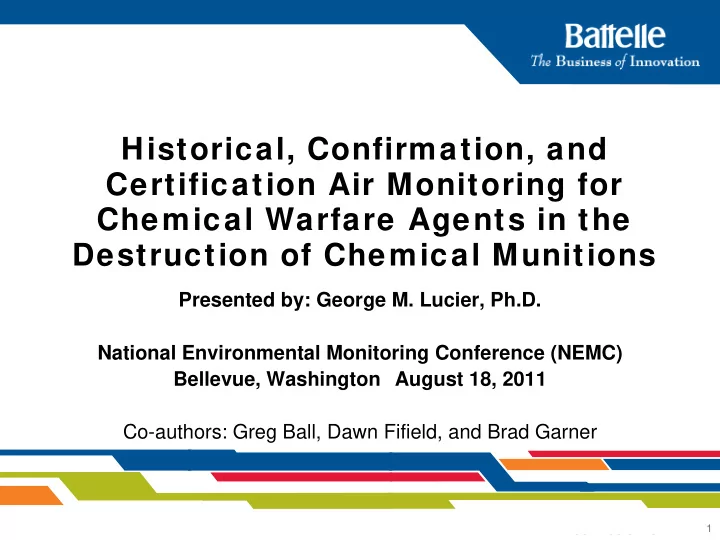

Historical, Confirmation, and Certification Air Monitoring for Chemical Warfare Agents in the Destruction of Chemical Munitions Presented by: George M. Lucier, Ph.D. National Environmental Monitoring Conference (NEMC) Bellevue, Washington August 18, 2011 Co-authors: Greg Ball, Dawn Fifield, and Brad Garner BUSINESS SENSITIVE 1
CWC Treaty Party States Source: http://www.opcw.org/news-publications/publications/facts-and-figures BUSINESS SENSITIVE 2
US Chemical Warfare Agent Stockpile Source: http://www.cma.army.mil/map.aspx BUSINESS SENSITIVE 3
Chemical Demilitarization Safety • The injury trend spanning all nine sites has shown significant improvement over the last 10 years 3.5 OSHA-recordable Injuries and Illnesses per 200,000 Hours 3.0 2.5 2.0 1.5 1.0 0.5 0.0 Dec-01 Jun-02 Dec-02 Jun-03 Dec-03 Jun-04 Dec-04 Jun-05 Dec-05 Jun-06 Dec-06 Jun-07 Dec-07 Jun-08 Dec-08 Jun-09 Dec-09 Jun-10 Dec-10 Jun-11 BUSINESS SENSITIVE 4
Air Monitoring for CWA • Near-Real-Time (NRT) monitoring of airborne CWA (described in the previous presentation) provides warning signals for safety and process control • Other needs for monitoring of airborne CWA: – Historical - Typically 4-hr or 12-hr time-weighted average (TWA) samples that create a continuous record of agent concentrations (or lack thereof) – Confirmation - Used to confirm or refute NRT readings or initial historical readings (e.g., to refute false-positive readings) – Certification (aka “non-baseline”) - Verifies waste, equipment, or work areas to be below hazardous levels of CWA so that they may be dispositioned or otherwise used by non-agent workers BUSINESS SENSITIVE 5
DAAMS Monitoring • DAAMS = Depot Area Air Monitoring System • Utilizes standard air-sampling practices for CWA historical, confirmation, or certification monitoring – Field samples are collected on a solid sorbent tube – Sample tubes are desorbed thermally into a GC or extracted for LC analysis (L only) – Priority sample results can be obtained in ~90 minutes • DAAMS monitoring complements NRT monitoring, offering higher precision and selectivity than NRT methods – together, they comprise the air monitoring that permits safe detection and destruction of CWA BUSINESS SENSITIVE 6
The TOCDF Mission • TOCDF is the largest and most complex of the facilities in terms of stockpile – Originally held 44% of the US stockpile of chemical weapons - Three nerve agents: VX, GB (sarin), and GA (tabun) - Two blister agents: HD (mustard gas) and Lewisite (L, an arsenical) - Weapons configurations included rockets, mines, projectiles, mortars, bombs, spray tanks, cartridges, and ton containers – Current TOCDF mission includes closure of CAMDS, the experimental prototype facility for destruction of the US stockpile of chemical weapons – Three separate laboratories exist to support the mission • To date, 99% of TOCDF’s agent has been destroyed BUSINESS SENSITIVE 7
Magnitude of the Monitoring at TOCDF • Spanning the five chemical warfare agents, more than 50 DAAMS “methods” are maintained on over 30 instruments for more than 200 sampling stations – Methods are defined by sampling parameters, analytical parameters, and general composition of the air matrix – All methods must meet Utah State regulator (RCRA) requirements, and each one must be individually evaluated and approved by the federal government (CMA) • Over 1400 DAAMS field samples are collected daily, most of which are 12-hour collections – Almost half of those samples collected are analyzed – The remainder are collected for confirmation purposes and are simply desorbed within 72 hours if they aren’t needed BUSINESS SENSITIVE 8
AELs and Detection Limits • Airborne Exposure Limits (AELs) that define the monitoring levels (in terms of air concentrations) are established in the Federal Register • Coupled with the DAAMS sampling and analytical parameters, the AELs define the detection-level masses for the methods – GB: 22 pg – GA: 60 pg [chromatographed as fluoro-tabun] – VX: 15 pg [chromatographed as G-analog] – HD: 1500 pg – L: 63 pg [chromatographed as the As( V) acid product] BUSINESS SENSITIVE 9
Statistical Evaluation and Trending • The large magnitude of the DAAMS program at TOCDF provides us with a large population of quality data for statistical evaluation and trending – Low-level and quality analysis trending - Provides early warning to upset conditions – Peak-integration consistency monitoring - Guards against non-standard peak-integration practices – Calibration stability tracking - Provides feedback for instrument maintenance practices – Retention time window width optimizing - Strives for a balance between false-negatives due to narrow RT windows and false-positives due to wide RT windows BUSINESS SENSITIVE 10
Field Sample Trending BUSINESS SENSITIVE 11
Field Sample Trending BUSINESS SENSITIVE 12
QC Samples • QP Analysis – daily analysis of agent-fortified field samples (QPs) provides the data necessary for statistical evaluation of method performance; represents about 20% of the field samples analyzed • QL Analysis – instrumental calibration verification samples (QLs) are analyzed at least one for every twenty field samples • QP and QL DAAMS tubes are spiked with a mass that corresponds to the monitoring level of interest for the specific DAAMS method BUSINESS SENSITIVE 13
QP Recovery Trending 8/24/2011 BUSINESS SENSITIVE 14
Peak Integration Consistency BUSINESS SENSITIVE 15
Peak Integration Consistency BUSINESS SENSITIVE 16
Calibration Stability Tracking BUSINESS SENSITIVE 17
Calibration Stability Tracking BUSINESS SENSITIVE 18
QP and QL Retention Time Data for Optimizing RT Window Widths BUSINESS SENSITIVE 19
Sample-Load-Weighted Mean RTW Width Trend BUSINESS SENSITIVE 20
The Future of DAAMS Monitoring • The two remaining (pre-systemization) CWA stockpile sites in the US account for 11% of the original US stockpile – These two sites will likely need DAAMS monitoring through the end of this decade • The direction of the non-stockpile program in the US regarding recovered chemical warfare material (RCWM) is not well-defined, but is likely to require DAAMS monitoring for decades to come • National and international considerations for CWA terrorism are likely to rely more on NRT monitoring than DAAMS BUSINESS SENSITIVE 21
Acknow ledgements • John Archer – TOCDF Laboratory Statistician – Provides ongoing statistical analysis and ad hoc reporting in support of TOCDF DAAMS method performance evaluation BUSINESS SENSITIVE 22
Recommend
More recommend